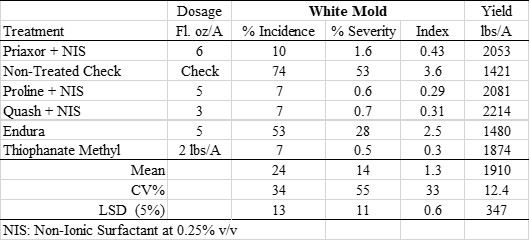The research trial was conducted at the Langdon Research Extension Center. The trial was planted on May 5th, 2016 with the canola variety “DKL 30-42 (Roundup Ready)” in a randomized complete block design and replicated four times. The trial location followed recommended practices for land preparation, fertilization, seeding rate and weed control.
The plot size was 5 ft. wide x 16 ft. long with a canola border between each plot. The trial was irrigated with an overhead sprinkler system set at 10 minutes every two hours from 7:00 PM to 6:00 AM beginning one week before the start of bloom to four weeks after bloom to help increase disease infection levels. Fungicides were applied at 20% bloom using a CO2-pressurized backpack style sprayer with a three nozzle boom (XR-8002) at 20 GPA. The level of white mold infection obtained in the research plots was completely from natural infection. Fifty plants were counted within each plot and the level of incidence was noted and severity levels were recorded for each plant prior to swathing on August 22 using a 0-5 scale, where 1=superficial lesions or small branch infected; 2=large branch(es) dead; 3=main stem at least 50% girdled; 4=main stem girdled but plant produced good seed; 5=main stem girdled, much reduced yield. A white mold disease severity index was calculated with a weighted scale of incidence and severity ratings.
Langdon received above average rainfall during the growing season. The results indicate there were significant differences obtained among the variables tested when compared with the non-treated check. The fungicide Quash, followed by Proline and Priaxor gave the highest yields. Whereas, Thiophanate-Methyl had the lowest white mold incidence, severity and index.
Acknowledgements: Bryan Hanson, Travis Hakanson and Lawrence Henry for their technical support
